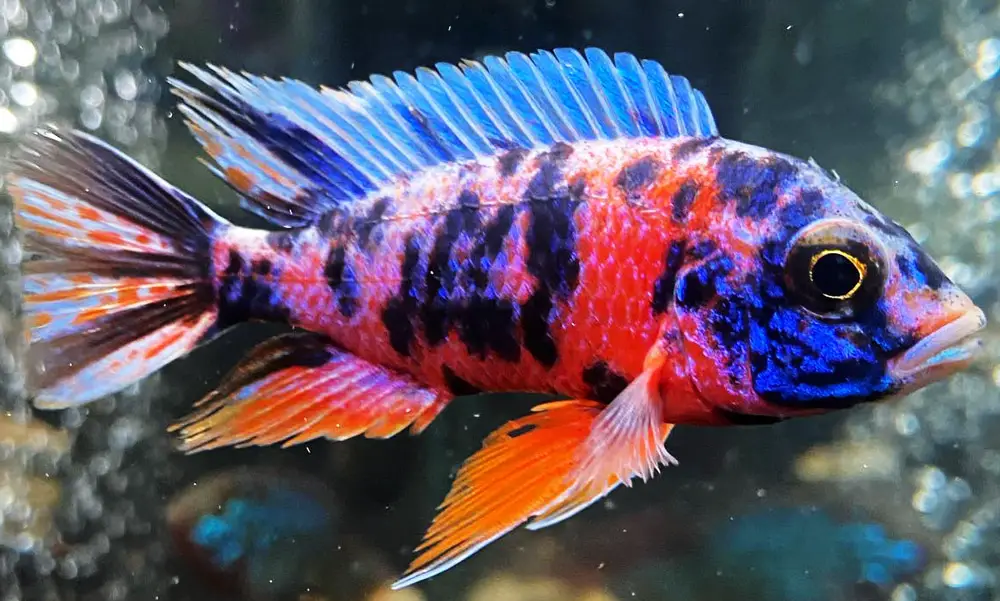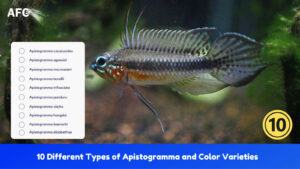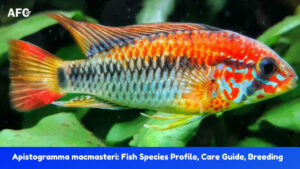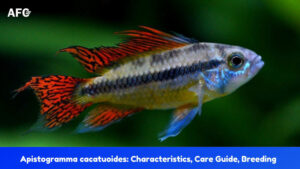Peacock Cichlids (Aulonocara spp.) are one of the most dazzling freshwater fish among African cichlid hobbyists owing to their incredible colors.
However, unlike the Aulonocara species that are endemic to Lake Malawi, the “OB Peacock cichlid” is a man-made hybrid with a mixed reputation in the cichlid keepers community.
Sure, they’re the most colorful fish and are cast in various shades. But they are also problematic for a few reasons.
In this article, let’s go into more detail about how they came to be and how you can take care of them if you choose to bring them home. Afterall, these stunning fish are simply very aggressive.
OB Peacock Cichlid Facts

Recently, I received a letter from an aquarist who was puzzled because two of her cichlids were thought to be different species but somehow managed to spawn together. She wanted to know if this was common and what she should do to care for the offspring.
Quite frequently, we would find similar questions in the community: “What is the proper name for these fish?”, “Are they rare species?” and “Can I sell them to get rich?.”
Virtually all these issues can be traced to Hybrid, which refers to the offspring from mating two genetically different species, often called “crossing” two species.
In the case of cichlids, hybrids are very rare in the wild but are quite readily in an aquarium. I can’t find enough data to support the claim but from my personal observation and years of reading and hearing from cichlids-related books and meetings.
A hybrid is most common in SA & CA cichlid tanks since almost any CA cichlids can hybridize with any other. A typical example is the convict cichlids – we often call them the rabbits of the fish world.
For a Malawi aquarium, many mbunas have the reputation of cross breeding. I heard some substrate spawners even can hybridize with a mouthbrooding species. So, hybridization in aquariums of Lake Malawi Cichlids is not rare.
What is An OB Peacock Cichlid?
The OB Peacock Cichlid is a hybrid that was initially created (deliberately or accidentally) by crossing an OB female mbuna (rock dweller) and a male Aulonocara species.
The term “OB” initially stands for “orange blotch” and referred to a natural random mutation of the scattered dark hyperpigmentation present on an orange base, resulting in varying black “blotches”. Nowadays, the “OB” is usually used to describe all “blotched” fish.
According to the research conducted by UMD, the ‘orange blotch’ morph or phenotype primarily shows up in females in nature, and males are quite rare. This is because males are not very picky in breeding and will mate with blotched females, but males with the OB gene usually have a low mating success rate when competing with normal colored males as the females prefer the more intense colored males.
Because of this, the OB morph Red Zebra Mbuna males (also called “marmalade cats”) are extremely rare in the wild, and the normal beige or brown-colored females have disappeared from the Minos Reef population.
The well-known Mbuna with OB genes include the Tropheops, Labeotropheus, Metriaclima, and Genyochromis. To develop an “OB Peacock”, breeders must breed the OB genes into Aulonocara species and Haps, then dominate the OB genes in males through selective breeding.
The Debate
A large number of scientists and breeders have long argued that man-made hybrids, like the OB peacock cichlid, should not be allowed in the hobby for the following reasons:
- Hybrids disrupt the natural order of things and weaken a species’s gene pool.
- Hybrids don’t have the desirable characteristics belonging to a purebred species.
- With more than 2300+ species of cichlids in the wild, there is no need to artificially create more because we can.
- Oftentimes, hybrids create enormous problems that may last for a long time and are difficult to eliminate.
- Hybrids are cheap but often sold at a hefty price. The potential owners may realize they’ve been cheated when the fish don’t look anything like what they expected. Eventually, they can turn hobbyists off to Cichlids.
On the other hand, many aquarists believe that hybrids can make a great addition to their tanks because:
- The captive breeding of hybrids has led to some amazing color morphs that are not found in nature. In some cases, hybrids are better than purebreds.
- To satisfy hobbyists’ insatiable appetites, exporters are tearing apart their natural habitats, causing great harm to many species in the wild. By buying hybrids, we can help relieve the pressure on wild populations.
As a hybrid owner, you’re in a unique position. I’m not going to tell you to destroy your fish immediately as other eager cichlid enthusiasts might. Instead, I encourage you to do your best to take care of them. Also, please be a responsible owner and NEVER release them into the wild, and don’t pass them on to other people in your local aquatic community or an LFS.
Lifespan
In my experience, OB Peacocks have lived between 5 and 8 years when kept in a well-maintained aquarium. Some have been known to live past a decade. It depends on your setup and how well you care for your fish.
Since this is a hybrid, another factor that can influence its lifespan is genetics. That is why it’s important to buy your fish from a reputable breeder.
OB Peacock Cichlid Size
The average size of an OB Peacock is around 4 to 7 inches (10 – 18 cm), with the females being on the smaller side and males getting a bit larger.
OB Peacock Cichlid Care
Whether you’re a beginner who just started your first Lake Malawi aquarium or a more experienced breeder having bred many species of African Cichlids for years, you WILL have fighting and deaths due to aggression.
If you want to keep cichlids but do not like the complex aggressive and territorial interaction of African Cichlids, don’t let them put you off, as there are plenty of peaceful and personalized South American cichlids that have much lower aggression issues.
While keeping OB Peacock Cichlid can be rewarding, they’re not the best fish for beginners. When it comes to peacocks care, there are no “rules,” only broad guidelines which are frequently broken. If you’re up for the challenge, here’s what you need to know about OB Peacock Cichlid care:
Tank Size
A minimum tank size suggested for these medium-sized OB peacock cichlids is 55 gallons (48″ x 13″ x 21″). If you want to keep them with other species in a community tank, you’ll need at least 100 gallons.
Like many other Mbunas, they do better when they are a little overcrowded. Furthermore, I suggest stocking your tank with only males to keep the aggression level down.
Here are some stocking numbers depending on the size of your aquarium:
| Size (Inches) | Light Stocking (55g/100g) | Medium Stocking(55g/100g) | Heavy Stocking(55g/100g) |
|---|---|---|---|
| 4″ | 5/10 | 16/32 | 49/98 |
| 5″ | 2/5 | 9/17 | 25/50 |
| 6″ | 1/3 | 4/9 | 15/29 |
Water Parameters
No matter what species are used to cross an OB peacock cichlid, these fish are endemic to Lake Malawi in Africa. The water in the lake is crystal clear with high alkalinity and a bit warmer than the natural habitat of other cichlid species.
- Water temperature: 72°F to 82°F (22.0 °C to 27.8 °C)
- pH levels: 7.7 to 8.6
- Water hardness: 6 – 10 dGH
In most cases, we should try to recreate the water conditions of their native habitat as much as possible. However, there are a few exceptions to this rule. These aggressive Lake Malawi or Lake Tanganyika cichlids are one of them.
Due to their aggressive nature, I prefer to keep them in a cooler water temperature because warmer water increases aggression in tropical fish. The average water temperature of Lake Malawi is 77°F (25 °C), so I like to keep my Malawi’s at 72°F to 77°F (22 °C to 25 °C).
Water stability is also important in keeping most cichlids, plus the aquariums are often heavy stocked, so strong filtration and regular large water changes are essential to maintaining the health of your fish.
Decor
OB peacock cichlids need a soft and sandy substrate because they may hunt for food near the bottom. A substrate of coral sand is recommended, which can help keep the pH level up and the water hard. However, these striking Malawi cichlids show their colors better on a dark substrate and aquarium background.
Provide plenty of caves and passageways built with piles of rocks for the fish to hide and explore, as this will also help reduce aggression. Ensure the rocks are placed securely, so they don’t fall and crush your fish.
Food & Diet
OB Peacocks are omnivorous. You can feed them high-quality pellets or flake food as a staple food.
For pellets, I recommend New Life Spectrum Cichlid Formula Pellets. They have a high concentration of quality natural color-enhancing ingredients, which will bring out the vibrant colors in your OB peacocks.
- New Life Spectrum is made from quality natural ingredients
- Extreme Color enhancement and vitality in your fish
- Made in the USA
Many aquarists told you should never feed your peacocks meaty food to avoid Malawi bloat. However, from my years of experience keeping Malawi cichlids, stress caused by poor water quality, improper diet, and water chemistry appears to be the major cause of bloat.
I’ve been feeding my Malawi cichlids with moderate amounts of frozen foods such as brine shrimp and Mysis shrimp once a week with no issues.
To supplement their diet, you can also feed them green peas every other day or vegetables like spinach and zucchini.
OB Peacock Cichlid Tank Mates
Perhaps the best reason to keep OB peacock cichlids in a small species-specific tank is their beauty- they are absolutely stunning fish. If you plan on breeding these fish, keep them in groups of at least three females for each male.
If you do want to keep them with other fish, I strongly recommend stocking any peacock community aquariums with only MALES. You can mix OB peacock cichlids with different hybrids, like Dragon Blood Peacocks or Flame Peacocks, but don’t mix them with relatively peaceful Aulonocara species since these hybrids can be very aggressive.
This fish can be kept successfully alongside many Haps and Mbunas, of course, only MALES due to the obvious reason we discussed above.
Here are some potential tank mates for OB peacock cichlids:
- Male Peacocks Hybrids: Dragon Bloods, Flames
- Male Labidochromis spp.: Yellow Labs, Red Top Hongi, and Pearl of Likoma
- Male small haps: Sulphur-headed Hap(O. lithobates), Deep-water hap (P.electra), Redfin hap (C. borleyi)
Once again, these are just based on my experience and observations. Some aquarists have had success with a much wider variety of tank mates, while others have not. It really depends on the individual fish and their personalities.
Breeding
Since breeding these fish will bring more enormous problems, we should not encourage you to do that. However, if you are determined to do that, here is some information.
OB Peacock cichlids are sexually dimorphic, with males taking on bright metallic colors while females have much duller coloration. Males are also slightly larger than females. Both sexes have the spotted pattern.
Like all other Aulonocara species and most Mbunas, these fish are maternal mouthbrooders. When they are spawning, the female will pick up her eggs immediately in her mouth and incubate them for about 21 days until the fry are developed big enough to swim on their own.
Conclusion
The OB peacock cichlid is one of the most popular and colorful Peacocks hybrids. They are stunning fish with beautiful colors and make a great addition to any Lake Malawi fish aquarium.
While the creation of these hybrids has caused some controversy, these fish are here to stay. If you own ob peacock cichlids or other hybrids, please be responsible and don’t pass them off as a purebred Aulonocara.
Thanks for reading, and I hope you enjoyed this article. Do you own an OB peacock cichlid? I would love to hear about your experiences in the comments section below.





